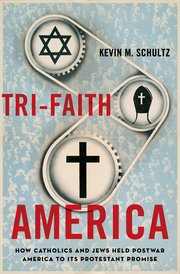Reviewed by Fred G. Zaspel
For virtually all of its history until the most recent generations no one could have questioned that America was a Christian nation. Just how “Christian” it actually was is another question, of course, but religiously this was how Americans understood themselves. Indeed, as late as 1942 an American President could confidently assert that America was a Protestant nation and use that fact to his own advantage. FDR reminded two high-ranking members of his administration — one Jewish and the other Catholic — that Jews and Catholics are here only “under suffrage” and that they would therefore have to “go along with what I want.”
That presidential conversation is scarcely imaginable today, barely 70 years later. Today, of course, pluralism reigns, and Americans seem convinced that not just Protestantism but not even Christianity itself — no religion has any preference over another, nor should it.
Symbolic of this seismic shift is the well-known event associated with the February 1943 sinking of the USS Dorchester when it was torpedoed by a German U-boat. The soon-to-be famous “Four Chaplains” aboard — one Jewish, one Catholic, two Protestants — willingly gave their life preservers to soldiers and went down to their watery grave together, arms joined in common prayer. As their story became famous via military advertisement, Hollywood, and even Philadelphia’s Chapel of the Four Chaplains, the emerging thinking was that when it comes to such times religious differences just don’t matter. And of course it was not long before Americans would elect a Catholic president, something that only a few years before would have been unimaginable. Religious alignments that FDR could use as political muscle no longer mattered.
Kevin Schultz (Associate Professor of History and Catholic Studies, University of Illinois at Chicago) demonstrates that the notion of “Tri-Faith America,” originating as early as the 1910s and 1920s came to full triumph in the post-war years and ranks with the labor and the civil rights issues of those days as a defining moment of change in the American mind. And the implications of this shift were deep and far-reaching, affecting relationships on every level — neighbor, society, race and ethnicity, the public school, religious and ecclesiastical alignments, and the heightening wall of separation between religion and the increasingly secular state.
In this fascinating book Schultz traces the origins of “Tri-Faith America” through its full blossoming in the 1950s and 1060s, and in his conclusion he highlights the conservative revolt and the varied and vigorous attempts to preserve societal and religious identity, a revolt that has not been able to win in the public discourse. For good or for ill the massive change has come, and this well-researched work in American intellectual history traces the story in an engaging way.
In short, Shultz displays Protestant America’s conversion to Judeo-Christian America and so, in turn, how today’s full-blown pluralism has come to shape the America that we are.
Fred G. Zaspel is Pastor of Reformed Baptist Church in Franconia, PA, professor of theology at Calvary Baptist Seminary, and executive editor here at Books At a Glance.
Buy the books

Tri-faith America: How Catholics And Jews Held Postwar America To Its Protestant Promise